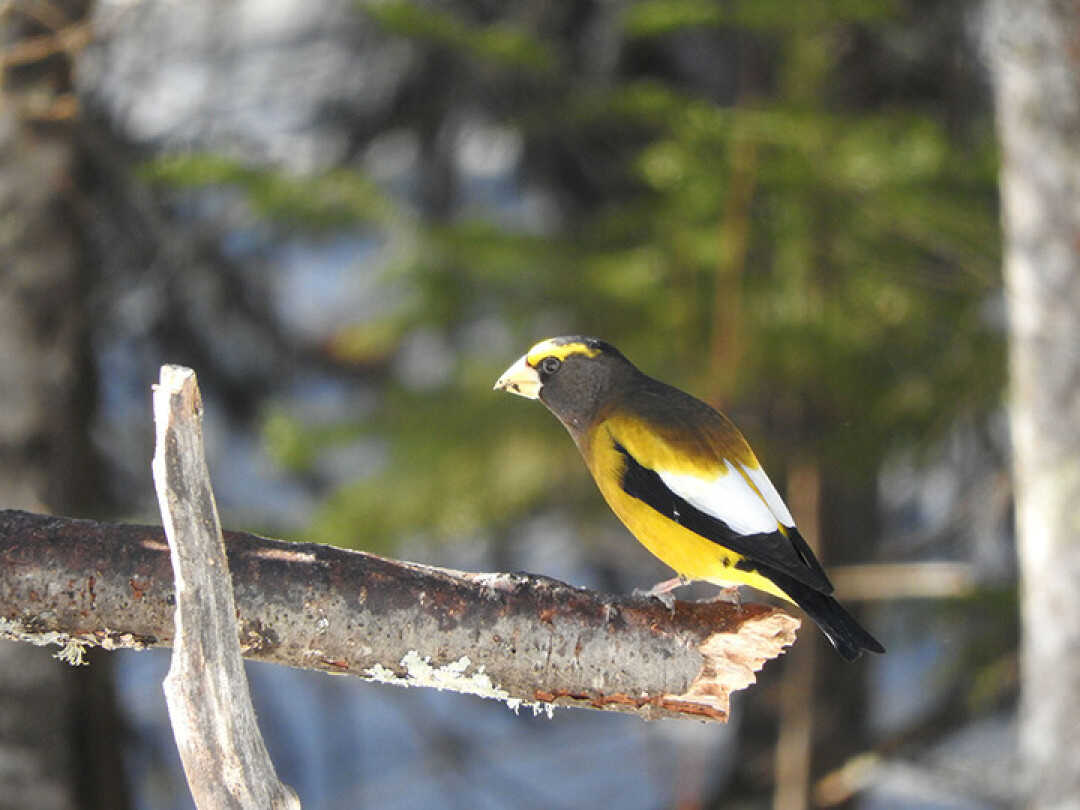The wandering Grosbeak

Evening grosbeaks are beautiful and infrequent winter visitors to our feeders. Photo by Emily Stone.
The vehicle pulled off to the side of the snow-packed gravel road was the first clue that we were about to see something exciting. I steered our car over as well, and my parents and I peered into the woods.
Movement and bright colors soon resolved into yellow birds with black and white wings hopping around a pile of black oil sunflower seeds. What luck!
My parents had driven up from Iowa, and then we’d all traveled more than 100 from northern Wisconsin to the Sax-Zim Bog Important Bird Area in northern Minnesota in order to see unusual birds. Here they were!
Evening grosbeaks are colorful members of the finch family. They got their name not because they are the color of the setting sun, but because English settlers thought the birds only came out of the woods to sing at sundown.
French settlers reportedly gave them the more accurate name of le gros-bec errant, the wandering grosbeak. These bright birds travel widely toward the best winter food sources in movements known as “irruptions.”
Here in Sax-Zim Bog, numerous bird feeders provide endless pounds of black oil sunflower seeds to entice grosbeaks into easily viewed locations. Out in the winter woods, evening grosbeaks are attracted to the large seeds of deciduous trees such as maples, ashes and box elders.
As my parents and I checked out several different feeding stations in the bog, we were treated to the antics of flocks of 20-40 evening grosbeaks flitting between feeders and trees and making the sunny air ring with their bright, warbled calls.
While those birds were fun to watch, even more impressive flocks have been spotted at feeders in Washburn, Ashland and Clam Lake, Wis. Ryan Brady, conservation biologist with the Wisconsin DNR, has been posting photos and videos of more than 100 evening grosbeaks in his yard for most of the winter.
And yet, that abundance is deceiving. Between 1966 and 2019, evening grosbeak populations declined by an estimated 74 percent. The causes of this decline are not fully understood, but likely stem from changes in both their winter and summer food sources.
Spruce budworms – the destructive caterpillars of a little brown moth – are a favorite baby food for evening grosbeaks. Grosbeaks are so good at detecting spruce budworms that an influx of the birds is often humans’ first clue to the start of an outbreak. The birds stuff their chicks full of the juicy, protein-packed larvae, and experience excellent nest success.
After a couple years of high caterpillar numbers and high bird reproduction, budworm outbreaks wane naturally. Large numbers of birds are faced with food shortages. Cycles of natural budworm outbreaks, and shifts in how much humans try to control outbreaks through aerial spraying, impact how much baby food grosbeaks have access to from year to year, and decade to decade.
Back in the 1800s, evening grosbeaks were mostly a western species. In the early 1900s they started to move east, mostly in winter. It was around this time that box elder was increasing in popularity as an ornamental tree, and would have provided a steady winter food supply.
In the 1950s, their winter food got another boost. During the post-World War II baby boom, box elder trees became a favorite landscaping tree in new housing developments.
While box elder was native to much of New England, it became much more common and moved north into parts of Maine and nearby Canada where it hadn’t been before. In addition, the 1970s saw extensive spruce budworm outbreaks. The dramatic increase in both their summer and winter food at this time may have meant that evening grosbeak populations were unnaturally high at the start of the period of decline.
Logging, spraying for budworm and diseases like West Nile likely ended the grosbeaks’ period of abundance. Now climate change threatens to disrupt our forests even more.
As balsam firs and spruces shift north in the face of warming temperatures, the summer food sources for evening grosbeaks might decline enough that they can no longer breed south of Canada.
None of that was at the forefront of our minds as we watched the birds in Sax-Zim Bog. Evening grosbeaks were not the only attraction. Eager Canada jays swooped in to lick peanut butter off sticks. A boreal chickadee took their turn at the fatty feast, too. Red-breasted nuthatches snacked on seeds. Pine grosbeaks added their beautiful rosy hue to the bird rainbow. And a northern hawk owl perched stoically in an aspen tree.
For this winter at least, we can enjoy a colorful visit from le gros-bec errant.
Emily Stone is Naturalist/Education Director at the Cable Natural History Museum. Emily’s award-winning second book, Natural Connections: Dreaming of an Elfin Skimmer, is now available to purchase at cablemuseum.org/books and at your local independent bookstore, too. For more than 50 years, the Cable Natural History Museum has served to connect you to the Northwoods. The Museum is now open with our exciting Growing Up WILD exhibit. Follow us on Facebook, Instagram, YouTube, and cablemuseum.org to see what we are up to.
